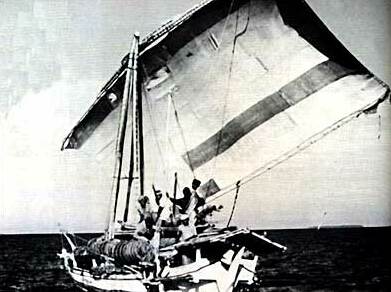Patorani on:
[Wikipedia]
[Google]
[Amazon]
 Patorani (also prauw patorani or perahu patorani) is a traditional fishing boat from
Patorani (also prauw patorani or perahu patorani) is a traditional fishing boat from
 The name "torani" means flying fish (
The name "torani" means flying fish (
 Patorani (also prauw patorani or perahu patorani) is a traditional fishing boat from
Patorani (also prauw patorani or perahu patorani) is a traditional fishing boat from Makassar
Makassar (, mak, ᨆᨀᨔᨑ, Mangkasara’, ) is the capital of the Indonesian province of South Sulawesi. It is the largest city in the region of Eastern Indonesia and the country's fifth-largest urban center after Jakarta, Surabaya, Med ...
, Indonesia. It is used by Macassan people for fishing, transport, and trading since at least 17th century A.D. Historically this type of boat was used by Gowa Sultanate
The Sultanate of Gowa (sometimes written as ''Goa''; not to be confused with Goa in India) was one of the great kingdoms in the history of Indonesia and the most successful kingdom in the South Sulawesi region. People of this kingdom come fr ...
as war boat.
Etymology
 The name "torani" means flying fish (
The name "torani" means flying fish (Exocoetidae
The Exocoetidae are a family of marine fish in the order Beloniformes class Actinopterygii, known colloquially as flying fish or flying cod. About 64 species are grouped in seven to nine genera. While they cannot fly in the same way a bird ...
).Horridge (2015). p.17 Patorani can be translated as "flying fish catcher".
Description
Patorani fishing boat has pajala type hull with Makassar-styled rudder mounting and tripod mast. The second tripod mast is supported by the roof of its deckhouse. This boat carried wood poles as a material for fishing and basket-shaped fish traps. The sail is usually canted rectangular sail orlateen sail
A lateen (from French ''latine'', meaning "Latin") or latin-rig is a triangular sail set on a long yard mounted at an angle on the mast, and running in a fore-and-aft direction. The settee can be considered to be an associated type of the same ...
. Some of them had bowsprit, adorned with pieces of wool, pendants, wooden fish carving, and other decorations. If the bowsprit
The bowsprit of a sailing vessel is a spar extending forward from the vessel's prow. The bowsprit is typically held down by a bobstay that counteracts the forces from the forestays. The word ''bowsprit'' is thought to originate from the Middle L ...
is not present, they are placed in the curved stempost.
Patorani design remains largely unchanged for several hundred years, but sometimes in the end of the 19th century, boat builders adopted frames and decking of European origins. Some of the frames reached above gun mount, and the tripod is used as pivot for 3 vertical stake that were connected to the flooring.Horridge (2015). p.18
See also
*Trepanging
Trepanging is the act of collection or harvesting of sea cucumbers, known in Indonesian as ''trepang'', Malay těripang, and used as food.
The collector, or fisher, of ''trepang'' is a trepanger.
Trepanging is comparable to clamming, crabbing ...
, act of collecting sea cucumber
* Makassan contact with Australia
* Mayang (boat)
Perahu Mayang or simply mayang is a type of fishing boat from Java, Indonesia. This type of boat is used mainly for fishing and trading. Historically, this indigenous vessel is also favored by European skippers and private merchants for trading in ...
* Jukung
A jukung or kano, also known as cadik is a small wooden Indonesian outrigger canoe. It is a traditional fishing boat, but newer uses include "Jukung Dives", using the boat as a vehicle for small groups of SCUBA divers.
The double outrigger juku ...
* Sandeq
A Sandeq is a type of outrigger sailboat or trimaran used by the Mandarese people for fishing and as a means of transportation between islands. The size of Sandeq varies, with hulls ranging from long and wide. Its carrying capacity ranges f ...
* Padewakang
Padewakang were traditional boats used by the Bugis, Mandar, and Makassar people, Makassar people of South Sulawesi. Padewakang were used for long distance voyages serving the south Sulawesi kingdoms.
Etymology
No-one quite seems to know the or ...
* Pencalang
Pencalang is a traditional merchant ship from Nusantara. Historically it was called as pantchiallang or pantjalang. It was originally built by Malay people from the area of Riau and the Malay Peninsula, but has been copied by Javanese shipwrigh ...
* Pinisi
Literally, the word pinisi refers to a type of rigging (the configuration of masts, sails and ropes (‘lines’)) of Indonesian Sailing ship, sailing vessels. A pinisi carries seven to eight sails on two masts, arranged like a gaff-ketch with w ...
References
Further reading
* Horridge, Adrian (2015). ''Perahu Layar Tradisional Nusantara''. Yogyakarta: Penerbit Ombak. An Indonesian translation of Horridge, Adrian (1985). ''The Prahu: Traditional Sailing Boat of Indonesia, second edition''. Oxford: Oxford University Press. {{Indonesian traditional vessels Sailboats Sailboat types Indonesian inventions Types of fishing vessels Military boats Austronesian ships Boats of Indonesia